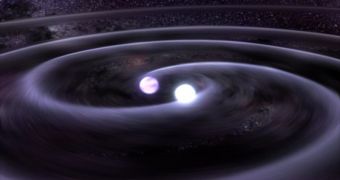An intense burst of gamma ray radiation, possibly coming from the Andromeda galaxy, has been detected in February last year, but, while trying to detect the gravitational wave produced by the event which triggered the radiation burst, scientists found there isn't one, thus ruling out the possibility of a merging between two black holes or neutron stars. Instead, an alternative theory suggests two possible events which might have led to the intense gamma ray burst: either the merging of two massive objects that took place somewhere in the background space beyond the Andromeda galaxy, or the existence of a type of pulsar or neutron star with extreme magnetic fields in one of the galaxy's spiral arms.
The findings were revealed during last month's 12th Gravitational Wave Data Analysis Workshop in Cambridge by Isabel Leonor from the University of Cambridge. Gamma ray bursts are the most powerful form of radiation emitted during violent events which take place in the universe. Thus, after the detection made by gamma ray satellites on 1st of February last year, scientists saw a great opportunity to measure the gravitational waves produced by a violent event such as the merging of two massive objects. The conclusion which astrophysicists reached came naturally as most of these intense gamma ray bursts are emitted during merging and coalescing event, and rarely from gamma ray repeaters such as magnetar stars that emit, most of the time, low level of gamma ray radiation.
Furthermore, the short bursts averaging less than 2 seconds backed up the scientists' original conclusion. However, while collecting data with two instruments of the Laser Interferometer Gravitational-Wave Observatory, the four kilometer and two kilometer gravitational interferometers located in Hanford, they were unable to detect any gravitational waves associated with the event dubbed GRB070201.
Gravitational wave was predicted by Albert Einstein's Theory of General Relativity, postulating that during interactions between objects with extreme accelerations, a wave propagates outwards through space-time producing distortions in the fabric of space. This would than be easily detected by monitoring the distances between two objects. Thus the LIGO instruments measure constantly the distance between two fixed mirrors with the help of lasers, which can pick up a variation in distance more than a thousand times smaller than the diameter of an atom.
The non-detection of the predicted gravitational waves represented a milestone in the understanding of the events which take place during these emissions. Before LIGO became operational, most of the objects that emitted intense gamma ray bursts were mostly studied through traditional methods such as measuring the electromagnetic emissions throughout most of the spectrum to make a rough image of the object responsible for the observed effects.

 14 DAY TRIAL //
14 DAY TRIAL //